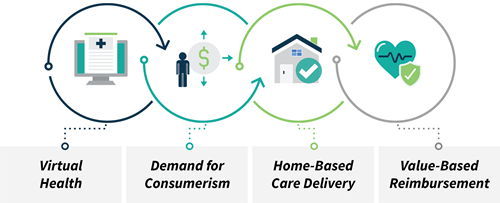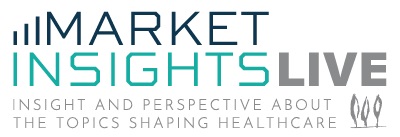Healthcare Technology Insights
Reimagining Healthcare Delivery: The Year That Changed Everything
September 10, 2020
The year 2020 will forever transform the healthcare industry and will serve as a historic inflection point for care delivery. COVID-19 has shown us the need for healthcare organizations to holistically reimagine the principles and mechanics of care delivery in preparation for the “New Normal.” In recent months, the industry has experienced a sharp rise in demand for innovative virtual health technologies and home-based care delivery models alongside an acceleration of long-standing, value-based care and consumerism trends. While these shifts and trends were present and occurring pre-pandemic, COVID-19 is the catalyzing event accelerating change by as much as 10 years across the ecosystem.
TripleTree will be exploring the reshaping of care delivery at the Market Insights LIVE thought leadership session on September 15th where TripleTree professionals and industry leaders from Bon Secours Mercy Health, KLAS, and Marwood Group will share in-depth perspectives on the themes and questions below.

Key questions and topics that will be explored during the Market Insights LIVE session include:
With a myriad of point solutions available, what does a holistic virtual health strategy that will create an end-to-end experience for patients and providers look like?
What virtual health technologies will have the greatest impact in the short, medium, and long-term? See Marwood Group’s recent blog for additional perspective on this topic.
What is the longevity of the current regulatory and reimbursement changes and how will changes impact utilization, adoption, and overall cost and quality? Marwood Group recently shared their perspectives on some of these topics in a recent blog.
How are payer/provider contracting dynamics evolving to reflect the rise in virtual health?
Demand for Consumerism: Consumer-centric, digital platforms have emerged in recent years to completely transform the way that consumers travel, bank, and shop. Healthcare has been slower to adapt to consumers because of the unique complexities of the market. The rapid adoption of virtual health technologies and shifting of care to the home alone have greatly accelerated the consumer experience in healthcare. As care continues to be decentralized, it will become increasingly important have automated consumer-centric platforms that schedule, triage, communicate, educate, guide, and enable self-management based on the patient’s clinical condition, insurance coverage and financial situation, and preferences.
Some of the key questions we will explore in Market Insights LIVE are:
How do providers use technology to revolutionize the end-to-end patient experience?
How can data (clinical & non-clinical) be utilized to personalize and automate workflows?
How are the non-clinical parts of the patient journey being transformed (e.g., scheduling, payments, etc.)?
Home-Based Care Delivery: The shift of care to the home is a long-standing, well-documented trend as it is a lower-cost care setting, seniors prefer to age in place, and there are unique clinical benefits to care in the home. COVID-19 has reinforced the importance of the home as a highly valuable clinical setting and has greatly accelerated the use of the home for care delivery. Ironically, this rise in home-based care delivery harkens back to the genesis of healthcare in the U.S. in the 19th century and early 20th century where the vast majority of care was decentralized and occurred in patients’ homes by local community physicians. The key difference today in the return of care to the home is the availability of advanced technology, logistics, equipment, and testing to make home-based care highly scalable and effective. Despite the positive tailwinds, however, home- and post-acute care delivery today is highly fragmented and is challenged by comprehensive coordination, communication, and patient data liquidity.
Some of the key questions we will explore in Market Insights LIVE are:
What is the right blend of technology and services to drive quality, cost, and scalability for home-based care delivery?
What are the strategies to drive engagement and adherence for seniors that may be less comfortable with technology?
What does a comprehensive, coordinated value-chain of technology and services for home-based care delivery look like (e.g., monitoring, virtual visits, in-home testing/labs, nutrition, transportation, self-management, HME/DME, sleep, etc.)?
Value-Based Reimbursement: Among the buzz words used in healthcare over the past decade, variations of “value-based care”, “value-based reimbursement”, and “fee-for-value” are certainly at the top of the list of most used. While we have seen movement as an industry toward quality programs, bundles, ACOs, and other risk-based models, the movement has been incremental. COVID-19 presents the opportunity for a massive leap forward toward value as the pandemic exposed clear shortcomings of fee-for-service payment models. In addition, COVID-19 has removed some of the historical barriers to a greater shift toward value (namely, a reliance on systems and processes designed for a fee-for-service world) while simultaneously adding catalysts (namely, the aforementioned acceleration of virtual care and home-based care delivery). According to Adam Flisser, MD, Director at Marwood Group, “The pandemic has forced a rethinking of value in healthcare. Our national unplanned experiment in the use of virtual care has showcased opportunities for payers and providers to re-examine the ways in which they previously siloed virtual care and has enabled us all to see where virtual care methodologies can lead to improved outcomes. ” For additional information, visit Marwood Group’s recent blog about a new value model in the wake of COVID-19.
Some of the key questions we will explore in Market Insights LIVE are:
What value-based reimbursement models are best positioned for accelerated adoption in the “new normal”?
What legacy technologies and processes need to be turned upside down to support this shift to value? What new technologies will be in high demand?
The opportunity to transform healthcare delivery has never been greater. We are excited to discuss and share perspectives on these and other themes changing healthcare delivery during our upcoming Market Insights LIVE thought leadership sessions – we hope to see you there! Until then, let us know what you think.

Reimagining Healthcare Delivery: The Year That Changed Everything
Tuesday, September 15 | 10:00 AM CT
Click Here to Register
AUTHOR(S)
TAGS
Bon Secours Mercy Health, Consumerism, Home Health, KLAS, Market Insights LIVE, Value-Based Care, virtual health



